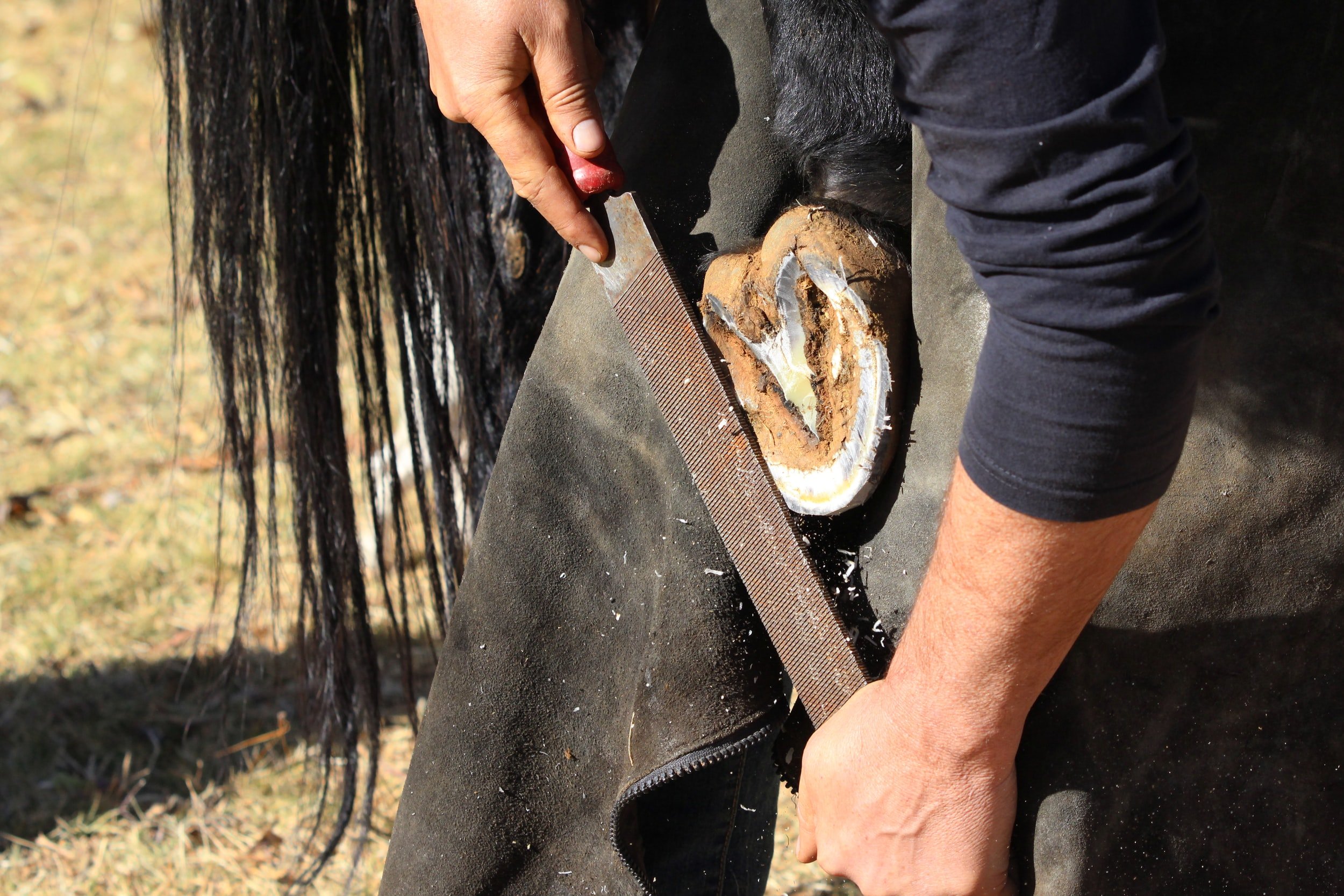Navigating Hoof Pain & Sensitivity
This is merely a stock photo, so don’t go judging this horses hoof & trim! We know nothing about their situation or the trim methods being used.
I should start out by saying that I am not against shoeing horses. Firstly, I strongly feel that there a lot of missed clues when it comes to why a horse may need shoes. Second, there are more options these days such as composite & glue on shoes and boots. All too often metal shoes are recommended for horses dealing with simple or complex hoof sensitivities and more. Quite frankly, this is often just a bandage. Often times issues still persists beneath a shoe, it’s just not showing its face as much. We also commonly see horses who just can’t keep a shoe on! The issue could be worsening over time without obvious signs (often the case of navicular treated with wedges) or new issues may begin brewing due to the shoe itself (from peripheral loading, heel contraction, underrun heels, long toes, mechanical imbalances, etc.).
If you’ve noticed that your horse is consistently landing toe first on one foot, or several feet, it’s time to take a closer look at things.
Wrong movement = detrimental. Right movement = rehabilitative.
Same thing goes for if you’re noticing sensitivity on hard ground, gravel, roots, and rocks - especially if it is getting worse over time.
You might be wondering what things are there to take a look at?
Diet
- Yes, the horses diet plays a HUGE role in hoof health. Just like humans, horses can have food sensitivities. Unfortunately, these food sensitivity symptoms can show up in the feet.
- A large number horses with hoof pain have shown a sensitivity to alfalfa and grass. If this is the case, access to these should be eliminated immediately.
- Excessive amounts of sugar and starch in grass, hay, & grain can also set the hoof up for sensitivity.
- Certain ingredients in grains, such as soy and wheat, can also cause hoof sensitivity.
- Another very important consideration to take into account is an unbalanced diet with improper mineral and vitamin ratios including excessive amounts of iron, which inhibits copper and zinc absorption, which is essential to hoof and skin health.
- Consider doing an elimination diet to see if things improve.
- Regardless, you may want to consider other forms of nutritional support for the hoof. See below for some recommended supplements and a link to learn more information.
Related Post: Nutrition for HoovesThrush, Bacteria or Fungus
Not sure if it’s just me, but when I was growing up, I was essentially taught that the horse can’t really feel their feet, but that the frog is the most sensitive area. That’s about it. That’s why nailing on shoes, scraping off sole and cutting away frog material was (generally) no big deal. Well, the horse can feel a lot, especially when the weight of their bodies is distributed through their feet.
Even the most mild cases of thrush can begin to eat away at precious protection. Should that thrush get worse, it can create tiny but big enough entry points for bacteria to begin infiltrating into the precious structures of the hoof. Any thrush deep within the collateral grooves, or the central sulcus of the frog, is a concern. Clean and treat daily until the infection clears and then treat weekly for maintenance.
White line “disease”, separation, or fungus is another issue that needs to be dealt with as it can mess with the integrity of the hoof wall connection. In the past, resections of the hoof wall have been the recommended method of treatment for this to air out the fungus, but balancing the diet and managing the fungus through soaking and other topicals is widely accepted practice in the “barefoot” world.
Related Post: Hoof Products & Thrush TreatmentTrim
In my opinion, if your farrier or trimmer is removing sole (as well as bars, heel and frogs) out of habit and for no specific reason (such as a build up of truly false sole or laid over bars that are causing bruising) you may want to consider asking them why they’re doing what they are doing. The trim they are performing on the hoof may be removing valuable protection that the hoof has laid down for a reason.
If the horse is comfortable before a trim, and then they seem sore afterwards… Well, there is a clue. They might be laying down sole or bars between trims, only for it to be pared away, after they’ve spent the last 6 weeks building it up.
Please Note: Trim methods and styles vary drastically, and everything is/should be tailored for each individual horse. I am not giving any specific trim advice or making any claims as to whether or not something should or shouldn’t be removed from the hoof in any situation. Hoof trimming, especially in regards to rehab, is a complex undertaking.



